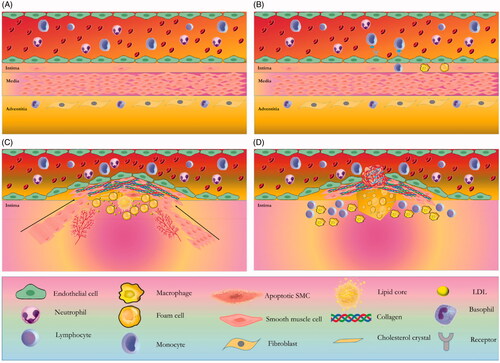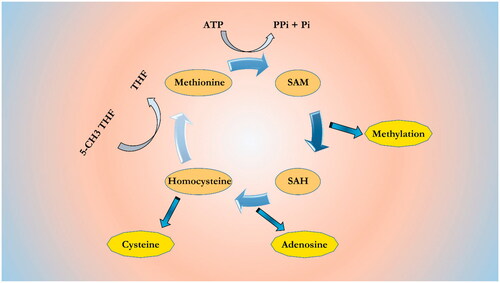Figures & data
Figure 1. Four stages in the atherosclerotic lesion formation. (A) In the normal and healthy situation, the normal artery has three layers. The intima layer or the inner layer consists of a monolayer of endothelial cells and resident smooth muscle cells (SMCs). The tunica media or the middle layer has several layers of SMCs which are embedded in a complex extracellular matrix. The adventitia, the outer layer, contains microvessels, nerve endings, mast cells, and fibroblasts. (B) The first stage is ECs activation through metabolic susceptible risk factors such as hyperlipidemia, adhesion of blood leukocytes such as monocytes to the activated monolayer of ECs, migration of monocyte into the intima, maturation of monocytes into macrophages, phagocytosis of LDL cholesterol that causes the formation of foam cells and phospholipid oxidation. (C) In the second stage, inflammatory condition and mediator effect leads to infiltration of SMCs from the media to the intima. High proliferation of media-derived SMCs and resident intimal SMCs, and an elevated production of extracellular matrix macromolecules, such as proteoglycans, elastin, and collagen leads to plaque formation. SMCs and plaque macrophages may die in advancing lesions through apoptosis. Extracellular lipid derived and apoptotic bodies from dying and dead cells can exacerbate the inflammatory condition. Advancing plaques also contain microvessels and cholesterol crystals. (D) The third and final stage is atherosclerotic plaque rupture and thrombosis, where it can impede blood flow.

Figure 2. Methionine-homocysteine cycle. SAM is synthesized from ATP and methionine. SAM is the common methyl donor for almost 50 different methyltransferases that recognize different methyl acceptors, such as proteins and nucleic acids. The SAH, demethylated product of SAM, is a powerful competitive methyltransferase inhibitor. Its accumulation is prevented by SAH hydrolase to homocysteine and adenosine. Homocysteine can be remethylated to methionine by 5-methyltetrahyfolate (5-CH3THF) or trans-sulfurated to cysteine.

Table 1. Atherosclerosis-related genes which are regulated through DNA methylation mechanism.
